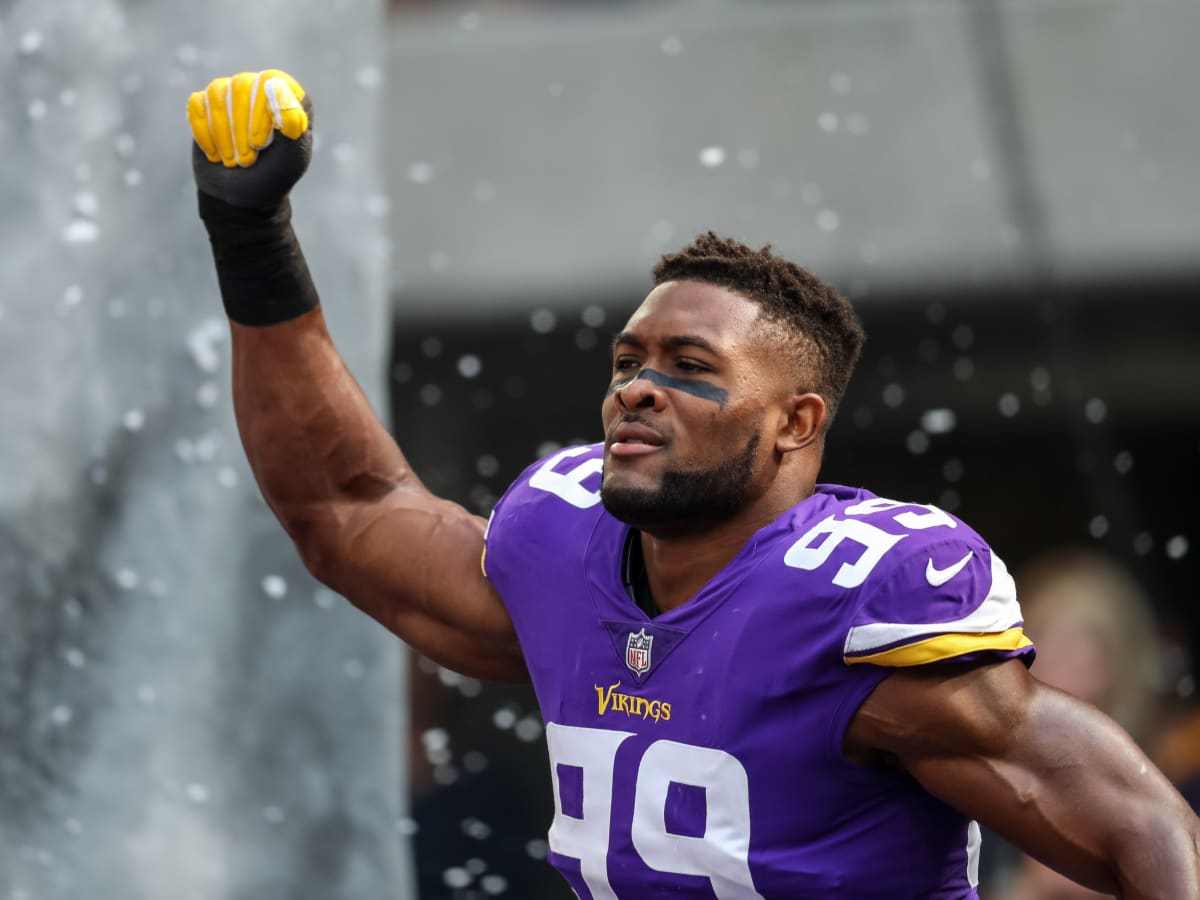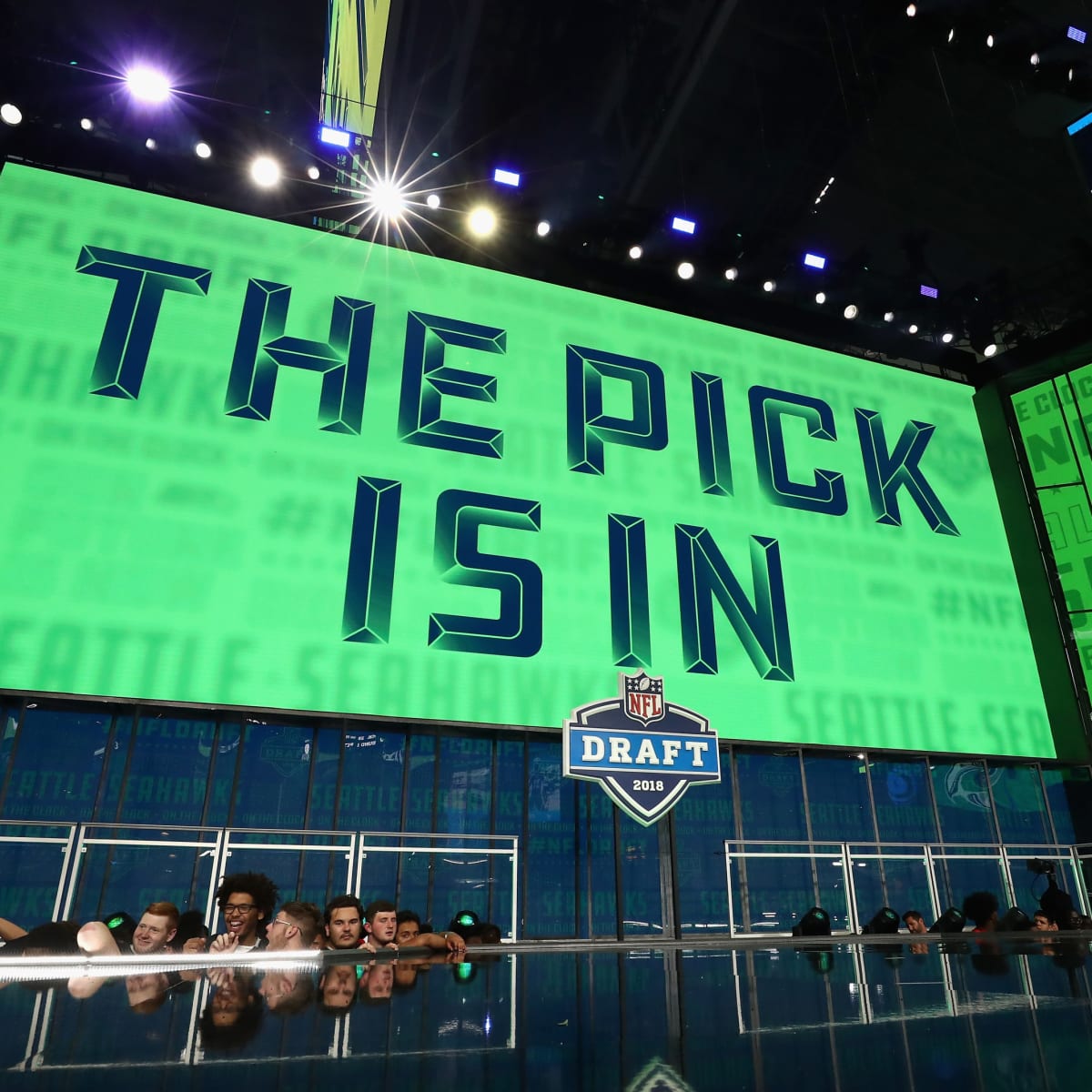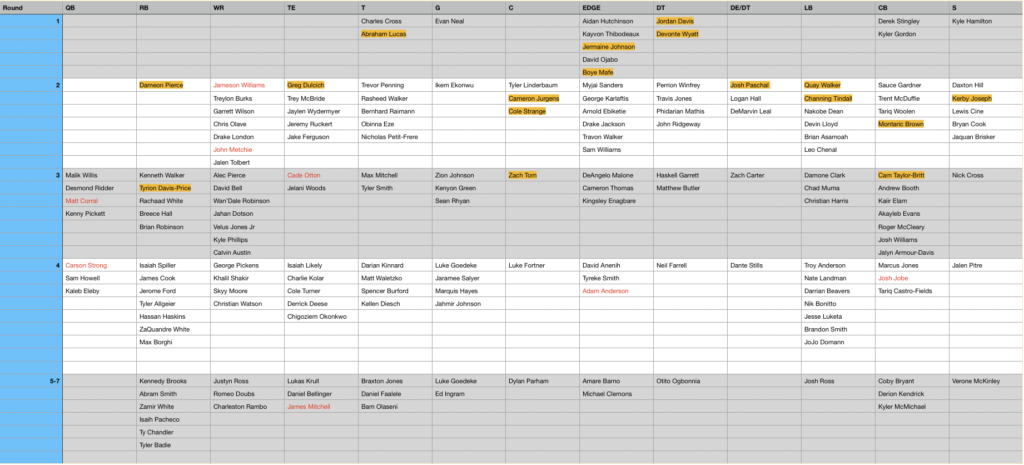
Introduction
The 2022 NFL draft lacks blue-chip talent, meaning teams selecting in the top-10 will be less enthused about their picks than you’d typically expect. However, what it lacks in elite big name stars, this class makes up in depth.
This is a loaded draft for the middle rounds. Players taken in round four might have second-round grades on some boards. The depth is also spread across numerous positions. Defensive ends, linebackers, receivers, running backs, tight ends, tackles.
The one area it is weak, however, is the most important position. Quarterback. How this impacts the off-season will be fascinating. It could lead to drama in the veteran trade market and it could mean players are taken far higher in the draft than their talent and potential warrants.
This could be the most important combine in years. The lack of top-10 talent means a good testing performance could elevate players up boards. With so many prospects graded closely, your physical profile could be especially significant in 2022.
Changes to the combine
With no event in 2021, it’s easy to forget what changes were made the previous year. It’s now a Thursday-to-Sunday schedule rather than Friday-to-Monday. The workouts take place later in the day to cater for a primetime audience.
The full schedule is listed below.
Adjustments were made to the drills — again to try and increase viewing figures. The ‘gauntlet’ drill for receivers and ‘W’ drill for defensive backs were timed so fans can compare how the players perform.
A ‘smoke route’ for quarterbacks and receivers involving a one-step hitch (which has become popular in RPO’s) was introduced and also timed. There was a ‘screen pass’ drill for offensive linemen to see how quickly and comfortably they can reach the second level. The mirror drill was different with the removal of a ‘rabbit’ running in front of the participating offensive lineman.
For defensive linemen there was a ‘figure eight’ drill (players also did this at the Senior Bowl). This is timed by teams. Sleds were used rather than coaches holding a bag for certain drills in 2020 but they didn’t operate properly and were replaced. We’ll see if the sledges return this year.
One big change is players will do the bench press on the same day as testing and on-field drills. I am not a big fan of the bench press anyway and would prefer a powerball toss — a better test of explosive upper-body power and not ‘cardio’ for the big linemen. There’s a chance many will skip the bench press this year due to the change.
Measurements also now take place on the day of testing.
One thing to remember
The short shuttle is important at every position. A lot of the focus is placed on forty times, explosive testing, drill performance — and rightly so. Yet the ability to change direction quickly with agility is vital across the board. You’ll notice how often it’s discussed in this review and how much value the Seahawks seem to place in it.
Unfortunately, with the NFL shifting the workouts to the evening for TV viewing figures, many players two years ago opted not to run the short shuttle. It was so late in the day by the time they’d run a 40 and participated in on-field drills, they skipped further testing through tiredness.
I fear this will be the case again. It’s why I think there should be financial ‘bonuses’ offered to players for a full workout.
Horizontal board
Here is how I have graded well over 150 players going into the combine.
Click the image to enlarge:

Workout schedule
» Thursday 3rd March (4-11pm ET): tight ends, quarterbacks, wide receivers
» Friday 4th March (4-11pm ET): offensive linemen, running backs
» Saturday 5th March (4-11pm ET): defensive linemen and linebackers
» Sunday 6th March (2-7pm ET): defensive backs, special teams
Groups 1-3 (TE, QB, WR)
Arrival: Monday 28th February
General medical exam: Tuesday 1st March
Media & NFLPA meeting: Wednesday 2nd March
Measurements, bench, drills: Thursday 3rd March
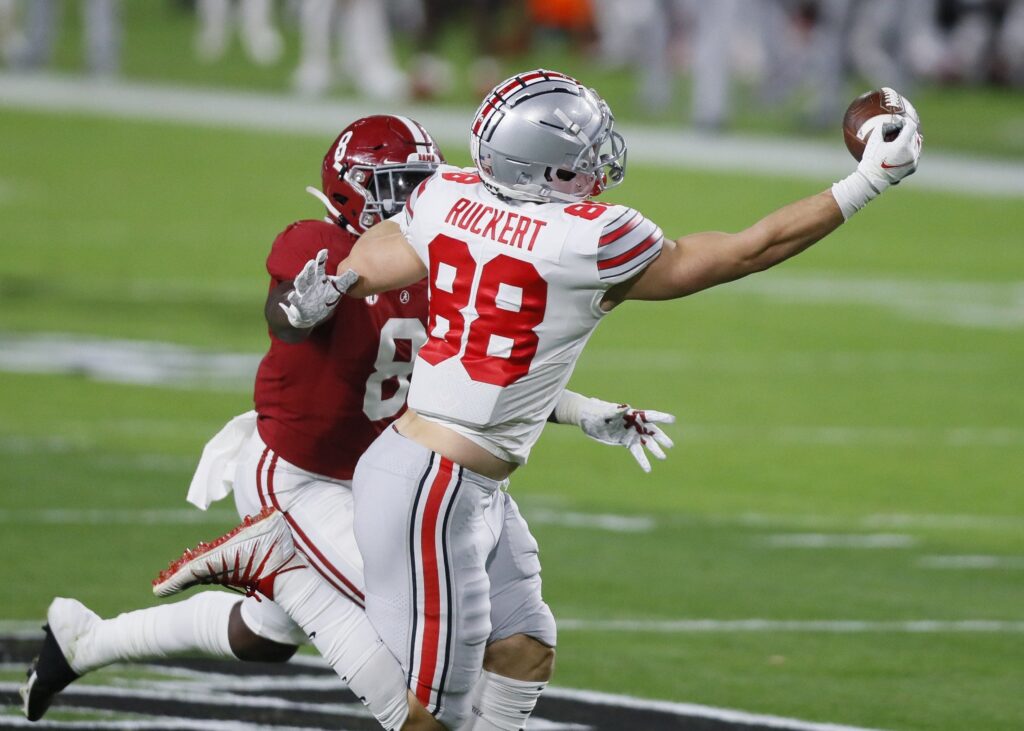
Jeremy Ruckert should excel in the short shuttle & vertical
Tight ends
Seattle has drafted five tight ends under Pete Carroll — Nick Vannett, Luke Willson, Anthony McCoy, Will Dissly and Colby Parkinson. They also traded for Jimmy Graham in 2015 and signed Zach Miller to a big contract in 2011. In the last two years they have signed Greg Olsen and Gerald Everett to one-year deals.
One thing links all nine players.
It appears the Seahawks view agility testing (short shuttle, three cone) as vital:
Luke Willson — 4.29 (ss), 7.08 (3c)
Will Dissly — 4.40 (ss), 7.07 (3c)
Nick Vannett — 4.20 (ss), 7.05 (3c)
Anthony McCoy — 4.57 (ss), 6.99 (3c)
Zach Miller — 4.42 (ss), 7.01 (3c)
Jimmy Graham — 4.45 (ss), 6.90 (3c)
Greg Olsen — 4.48 (ss), 7.04 (3c)
Colby Parkinson — 4.46 (ss), 7.15 (3c)
Gerald Everett — 4.33 (ss), 6.99 (3c)
Tony Pauline also linked the Seahawks with interest in Atlanta’s free agent Austin Hooper before he signed with Cleveland. He ran a 4.32 short shuttle and a 7.00 three cone. It was also speculated that they really liked O.J. Howard in the 2017 draft. He had the top short shuttle in his class (4.16) and a fantastic three cone (6.85).
Short-area quickness and agility appears to be important for any prospective Seattle tight end so pay close attention to the short shuttle and the three cone.
Key tests
Short shuttle, three cone, vertical
Ideal size
6-5, 250-265lbs, +33-inch arms, +10-inch hands
Positional assessment
This is the deepest and best tight end class in years. We could see 10 players drafted before the end of day two. There isn’t a Kyle Pitts type, destined to go early in round one. Yet there’s rich depth at the position with plenty of rounded prospects, capable of contributing early in their careers.
Interesting note
The last time we had a strong tight end draft was five years ago in 2017. The Seahawks, unexpectedly, passed on the position. They drafted seven players before George Kittle was selected in round five by the 49ers — despite his good combine and dynamism as a blocker. Seattle even spent five picks in rounds 3-4 without taking Kittle. Given how much attention they place on agility, it’s possible Kittle’s 4.55 short shuttle played a part in that decision.
Best drill to watch
Catching technique is always important so look for how a player uses his hands. Is he cupping them to the ball? I always like to see TE’s who can move naturally on seam routes and change direction during drills.
Five names to watch
Jeremy Ruckert, Greg Dulcich, Trey McBride, Jake Ferguson, Jalen Wydermyer
Potential standout
Jeremy Ruckert scored a 114.27 at SPARQ, including a 35 inch vertical and a 4.40 short shuttle. However — keep an eye out for Jake Ferguson performing better than expected. He once ran a 4.15 short shuttle.
Importance to the Seahawks?
Will Dissly and Gerald Everett are free agents. The only tight end on the roster is Colby Parkinson. Unless the Seahawks retain or replace both Dissly and Everett, there’s every chance they’ll draft a player from this class — perhaps in round four.
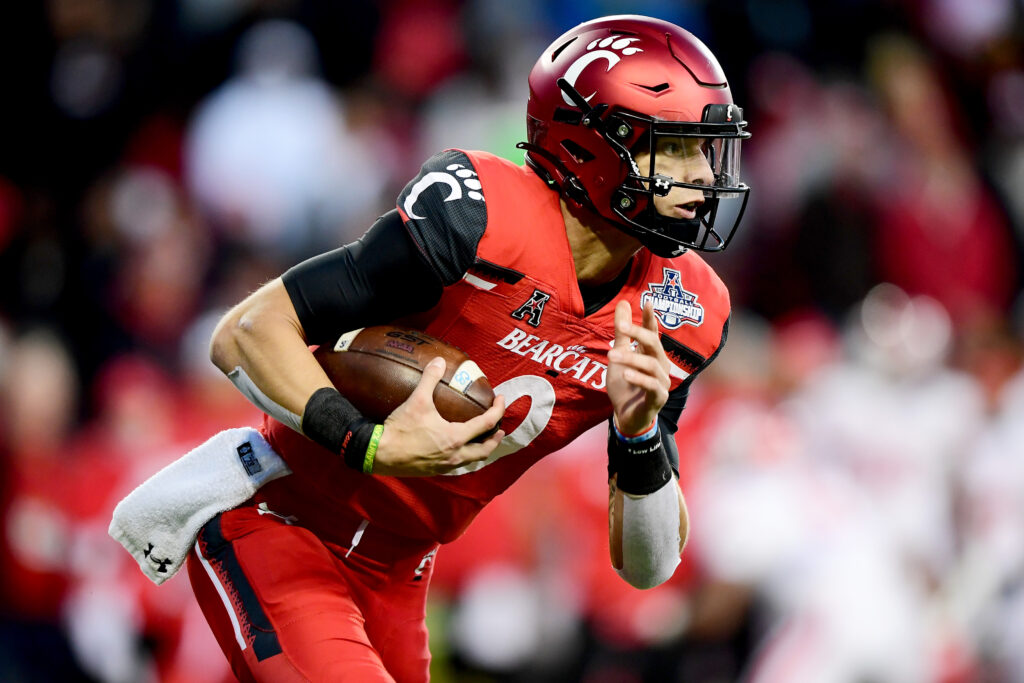
Desmond Ridder is expected to run in the 4.4’s or 4.5’s
Quarterbacks
This likely won’t be a positional group that intrigues Seahawks fans this year. It’s a mediocre class and short of a dramatic Russell Wilson trade, there’s unlikely to be any picks spent on the position.
Key tests
Deep throws
Ideal size
+6-1, 220lbs, +9.5 inch hands
Positional assessment
It’s well known by now that this is a weak quarterback class. I’m torn between Malik Willis and Desmond Ridder being the best of a bad group. Willis has the physical tools but can’t read the field. Ridder is a born leader with great athleticism but he shows erratic accuracy and decision making. Any player drafted in round one will be a reach. There will be a lot of attention placed on Kenny Pickett’s hand measurement. He’s said to have 8 1/4 inch hands.
Interesting note
The Seahawks have only drafted two quarterbacks in the Pete Carroll era — Russell Wilson (third round, 2012) and Alex McGough (seventh round, 2018).
The best drill to watch
Everyone wants to see the top QB’s throw the deep ball. They’re not facing a defense. They’re just standing in shorts and throwing the football. You learn very little from the QB’s at the combine outside of meetings and interviews. The only real reason to watch the drills is to see which players stand out throwing downfield with power and precision with reasonable mechanics.
Five names to watch
Desmond Ridder, Malik Willis, Matt Corral, Kenny Pickett, Kaleb Eleby
Potential standout
Malik Willis is a terrific athlete but Desmond Ridder is expected to run in the 4.5’s, potentially nail a 4.00 short shuttle and jump well in the broad/vertical. Due to the Senior Bowl measurements, we already know Ridder has +10 inch hands.
Importance to the Seahawks
At the moment, not at all. It’s possible they spend a last day pick on a QB to develop as a backup but aren’t they better off just rolling with Jacob Eason? It is peculiar that they’ve only drafted two quarterbacks since 2010. Yet with needs at various positions this off-season and the Seahawks seemingly in a hurry to return to contention, it seems unlikely they’ll spend a significant pick on a quarterback.
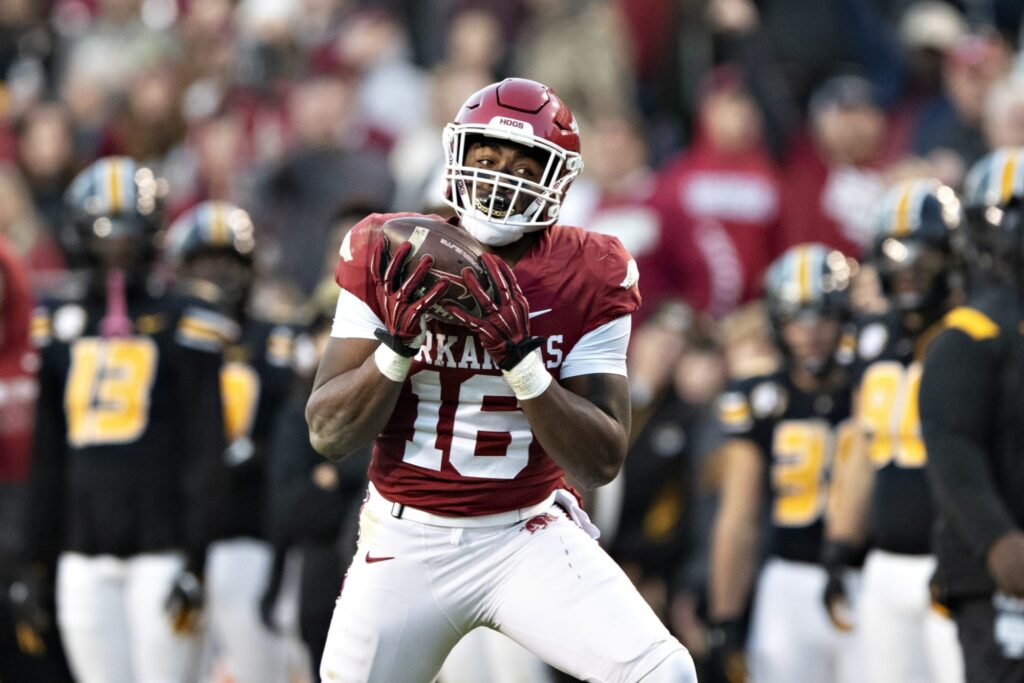
Treylon Burks has been compared to A.J. Brown
Wide receivers
Pete Carroll has only drafted three receivers who haven’t run a 4.4 forty or faster:
Kenny Lawler — 4.64
Chris Harper — 4.50
John Ursua — 4.56
The rest all cracked the 4.4’s:
Paul Richardson — 4.40
Golden Tate — 4.42
Tyler Lockett — 4.40
Kris Durham — 4.46
Kevin Norwood — 4.48
Amara Darboh — 4.45
David Moore — 4.42
D.K. Metcalf — 4.33
Freddie Swain — 4.46
Dee Eskridge — 4.38
We have enough data now to say definitively — unless a player runs a 4.4 or faster, the Seahawks are unlikely to consider them until the later rounds. Clearly they value speed and suddenness at the position even if you’re a ‘bigger’ receiver.
The entire NFL acknowledges the need for speed. The days of the classic ‘possession’ receiver are over. Teams are utilising tight ends in a variety of creative ways to get a sizeable mismatch target on the field. For receivers playing outside or in the slot, quickness is the desired trait.
The ability to separate is vital whatever your size. Watch the forty, the 10-yard split, the three-cone and short shuttle. It’ll provide a clear indication on which players have the quickness and agility to create openings.
Positional assessment
The way the game has evolved means college football regularly churns out talented receivers. There might not be a Ja’Marr Chase in this class but we’ll likely see multiple first and second round receivers — with depth stretching deep into rounds three, four and five. It’s another chunky receiver class.
Interesting note
Carroll’s Seahawks don’t really have a ‘range’ where they take receivers. They’ve drafted four players in round two (Tate, Richardson, Metcalf, Eskridge), two in round three (Darboh, Lockett), three in round four (Norwood, Harper, Durham), one in round six (Swain) and three in round seven (Moore, Lawler, Ursua). They traded a first round pick for Percy Harvin. They’ve also had a degree of success with UDFA’s. The best non-FA athlete Seattle has acquired in the Carroll era was an UDFA — Ricardo Lockette. He ran a 4.41, had a 39-inch vertical and a 6.76 three-cone. He was also well-sized at 211lbs with 33.5-inch arms.
Key tests
Forty, vertical, catching drills (proper technique)
Ideal size
Just run a 4.4 forty or faster
The best drill to watch
Any drill that clearly shows catching technique. It’s extremely important. You want to see a receiver cupping his hands while presenting to the ball. No alligator arms, no fighting the ball or snatching at it. Watch the downfield throws too and see who is good at high pointing the football, showing body control and tracking over the shoulder. Who is a natural hands catcher?
Five names to watch
Treylon Burks, Jalen Tolbert, Alec Pierce, Kyle Phillips, Wan’Dale Robinson
Potential standout
Treylon Burks has 10 3/4 inch hands which is incredible. There are mixed noises on how he’s performing in training for the combine but he has the potential to run a fast time for a bigger receiver.
Importance to the Seahawks
After spending another high pick on Dee Eskridge a year ago, it’s likely not a position they’ll target early again this year. If the right player is available on day three, it’s a possibility. If the Seahawks want another receiver, they should seek value in the veteran market and save the picks for other positions unless they’re presented with a can’t-miss opportunity.
Groups 4-5 (OL, RB)
Arrival: Tuesday 1st March
General medical exam: Wednesday 2nd March
Media & NFLPA meeting: Thursday 3rd March
Measurements, bench, drills: Friday 4th March
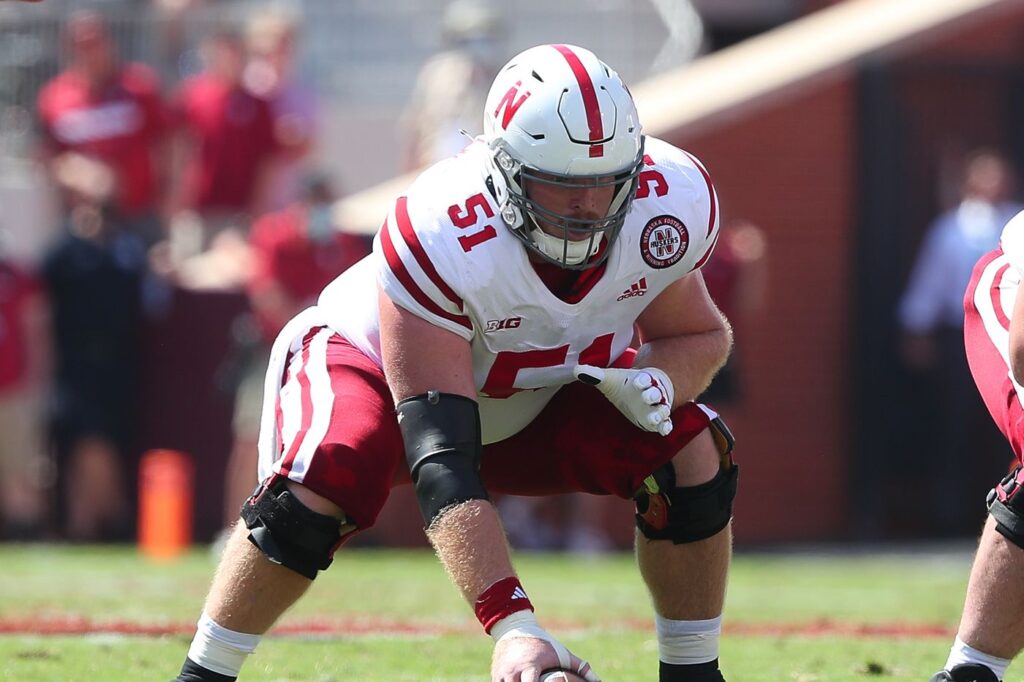
Cameron Jurgens should be among the explosive O-line testers
Offensive linemen
For the last few years we’ve used a formula called TEF to measure explosive physical traits. It proved to be an accurate way of predicting which offensive linemen the Seahawks might be targeting. When Tom Cable departed after the 2017 season we wondered if TEF would be as useful moving forward (due to his influence on the system). Yet the Seahawks drafted Phil Haynes in 2019 — the second best TEF scorer in the 2019 draft — and Damien Lewis — another explosive lineman — in 2020.
It’s unclear if this will change after the Seahawks replaced Mike Solari with Andy Dickerson. The Rams did not place as much emphasis on explosive traits. For example, here’s a run down of several of their linemen and how they scored in TEF:
Brian Allen — 2.63
Austin Corbett — 2.55
Rob Havenstein — 2.36
David Edwards — 2.19
Joseph Noteboom — 2.62
Andrew Whitworth, their ageing left tackle, scored a 3.14 at the 2006 combine.
There’s no real rhyme or reason to the way the Rams selected their players. Noteboom and Corbett are both very athletic — testing particularly well in the short shuttle. Yet Allen, Edwards and Havenstein ran times you’d expect from a random member of the public.
We may well discover this year that the preference for explosive linemen is a Pete Carroll thing, rather than anything specific to the coaches he’s hired.
After all, Pat Kirwan — a confidant of Pete Carroll — tells us why in this piece:
Every time a ball is snapped to start a play there is a critical element of explosiveness that takes place. When two players collide in an attempt to physically dominate each other, the athlete with the edge in explosiveness has the best chance to win the confrontation. It could be a blocker vs. a tackler, a tackler vs. a ball carrier, or many other examples of winning at the point of contact.
Explosiveness is defined in the dictionary as a violent release of energy, a sudden outburst. Football is a series of explosions. How do you measure it in athletes trying to play NFL football?
Take the vertical jump, standing broad jump and the bench press test results and add them together. If the combined score is over 70 there is a reason to consider the candidate at some point in the draft process for his explosiveness.
Kirwan’s formula is flawed because it diminishes the impact of the broad jump. A superb 9-7 only achieves a 1.2 point advantage over a below par 8-5. That’s why TEF was created — to do what Kirwan intended and measure explosive traits equally and emphasise their combined importance.
I sense, based on what Kirwan wrote about, that Carroll believes in the importance of explosive traits up front. The NFL tends to agree. Increasingly we are seeing explosive testers drafted early.
Four years ago, only seven offensive linemen scored an optimal 3.00 or higher in TEF. Of the seven, Quenton Nelson and Kolton Miller were both high first round picks. Braden Smith, Connor Williams and Will Hernandez were second round picks.
In 2019, only eight players scored an optimal 3.00 or higher. This included Chris Lindstrom, Garrett Bradbury, Andre Dillard and Kaleb McGary (all drafted in round one). Erik McCoy and Elgton Jenkins were also top-50 picks.
In 2020 there were only eight ‘explosive’ testers scoring a 3.00 or higher. Tristan Wirfs, Cesar Ruiz and Austin Jackson were all first round picks. Ezra Cleveland was a second round pick and Matt Peart was taken in round three.
Last year, although there was no combine, we collected TEF data from pro-day events. Penei Sewell, Rashawn Slater, Alijah Vera-Tucker and Alex Leatherwood were all deemed to be top-level explosive testers and all went in the top-20. Teven Jenkins, Liam Eichenburg, Sam Cosmi, Dillon Radunz and Creed Humphrey were second round picks. Brady Christensen, Kendrick Green, Spencer Brown and Quinn Meinerz went in round three.
It’s not a coincidence that the most explosive offensive linemen are being drafted early. Expect that to continue.
Jumping a vertical at 320lbs is considerably more challenging than jumping a vertical at 275lbs. Thus, we created a second formula (weighted TEF or wTEF) to account for weight:
Weight x TEF x 0.1
We can give each player a score that sufficiently emphasises their unique size. For example:
Germain Ifedi — 324 x 2.97 x 0.1 = 96.1
Phil Haynes scored a 103.7 for example. For more information on weighted TEF, click here.
TEF is not an attempt to determine who is a good or bad offensive linemen. It’s merely a calculation to judge explosive traits. While that’s only one part of any evaluation — it’s clear the league pays attention to it.
For a full breakdown of the TEF calculation, click here.
Key tests
Vertical, Broad, Bench
Ideal size
6-3/6-5, 305-320lbs, +33 inch arms, +31 inch vertical, +9’ broad, +30 bench reps
Positional assessment
There are a collection of intriguing offensive tackles in this class but the depth in the interior is lacking. It will be far harder to find an immediate starter at center although the likes of Cole Strange and Cameron Jurgens offer hope. Most of the guard prospects are converted tackles. The premium nature of the tackle position plus the continuing desperate need across the NFL could mean several players really promote their stock with a good combine. If Seattle needs a tackle at #41, there’s a reasonable chance a good one will be available.
Interesting note
For a long time we’ve been discussing the league-wide problem of the athletic discrepancy between college O-lines and D-lines. At the last five combines there were a total of 116 ‘explosive’ defensive linemen (explosive = a TEF score of 3.00 or higher). In comparison, there were only 32 explosive offensive linemen. This remains a big problem for NFL teams.
The best drill to watch
The mirror drill and kick-slide. In the mirror, two linemen used to stand opposite each other, with one acting as ‘the rabbit’. He’d move around and change direction and it’s up to the participant to stick. Now they don’t use the ‘rabbit’. It’s an important test of footwork, agility, mobility, balance, control and stamina. It’s also a good gauge of pass protection skills. In the kick-slide, it speaks for itself. How well do the offensive tackles get into position, how athletic do they do it, what’s the footwork like?
Five names to watch
Guard — Evan Neal, Ikem Ekonwu, Zion Johnson, Kenyon Green, Bernhard Raimann
Center — Cameron Jurgens, Tyler Linderbaum, Cole Strange, Zach Tom, Luke Fortner
Tackle — Abraham Lucas, Rasheed Walker, Obinna Eze, Tyler Smith, Nicholas Petit-Frere
Potential standout
Evan Neal ranked #1 in Bruce Feldman’s freak list for 2021. Cameron Jurgens ran a 4.98 at SPARQ and jumped a 32 inch vertical. Abraham Lucas ran a 4.30 short shuttle at SPARQ.
Importance to the Seahawks
Duane Brown and Brandon Shell are both free agents, so tackle could be their #1 priority by draft day depending on what happens over the next few weeks. Ethan Pocic is also set to test the market. It’s clear the Seahawks need to add and/or retain players on the O-line. With a number of potentially attractive pass rushing options in free agency — they could address their defensive front with a big veteran addition (or two) and wait on the draft to bring in a new tackle. There’s a lot of work to be done up front and the trenches are key to the future success of this team.
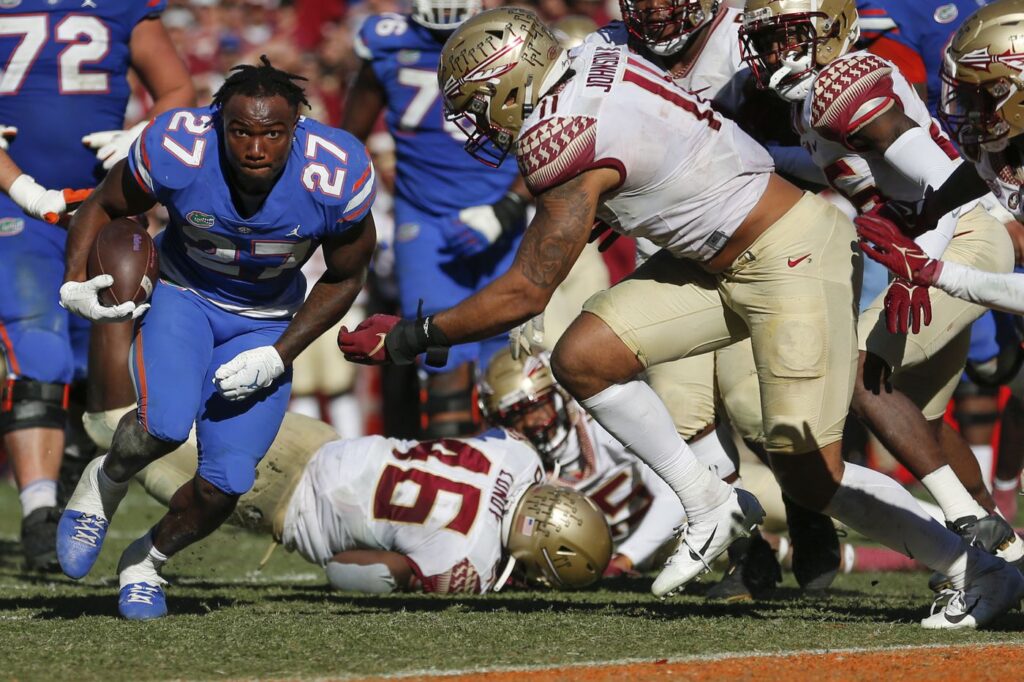
Dameon Pierce will have a workout to remember
Running backs
The Seahawks have a type at running back. They’ve consistently drafted players with a similar physical profile. It’s made it fairly straight forward to figure out who they might like. Here are the players we identified from the 2016, 2017, 2018 and 2020 combines as probable targets:
2016:
C.J. Prosise — 6-0, 220lbs, 35.5 inch vert, 10-1 broad
Kenneth Dixon — 5-10, 215lbs, 37.5 inch vert, 10-8 broad
2017:
Christopher Carson — 6-0, 218lbs, 37 inch vert, 10-10 broad
Brian Hill — 6-0, 219lbs, 34 inch vert, 10-5 broad
Alvin Kamara — 5-10, 214lbs, 39.5 inch vert, 10-11 broad
Joe Williams — 5-11, 210lbs, 35 inch vert, 10-5 broad
2018:
Saquon Barkley — 6-0, 233lbs, 41 inch vert DNP broad
Kerryon Johnson — 511, 213lbs 40 inch vert, 10-6 broad
Bo Scarborough — 6-0, 228lbs, 40 inch vert, 10-9 broad
Nick Chubb — 5-11, 227lbs, 38.5 inch vert, 10-8 broad
John Kelly — 5-10, 216lbs, 35 inch vert, 10-0 broad
Lavon Coleman — 5-10, 223lbs, 33 inch vert, 10-0 broad
Rashaad Penny — 5-11, 220lbs, 32.5 inch vert, 10-0 broad
Royce Freeman — 5-11, 229lbs, 34 inch vert, 9-10 broad
2020:
Jonathan Taylor — 5-10, 226lbs, 36 inch vert, 10-3 broad
Cam Akers — 5-10, 217lbs, 35.5 inch vert, 10-2 broad
Deejay Dallas — 5-10, 217lbs, 33.5 inch vert, 9-11 broad
AJ Dillon — 6-0, 247lbs, 41 inch vert, 10-11 broad
Zack Moss — 5-9, 223lbs, 33 inch vert, DNP broad
James Robinson — 5-9, 219lbs, 40 inch vert, 10-5 broad
Patrick Taylor — 6-0, 217lbs, 34 inch vert, 10-3 broad
They drafted a player from each of the groups — Prosise, Carson, Penny and Dallas. They eventually added Bo Scarborough too and admitted significant interest in James Robinson as an UDFA (John Schenider recently said he was on the brink of signing with the Seahawks, before opting for Jacksonville).
In 2019 we identified Alex Barnes, Damien Harris, Alexander Mattison, LJ Scott, Miles Sanders, Dexter Williams and Tony Pollard as possible options. Running back was an unlikely target though with the depth they had at the position. With a strong emphasis on special teams improvement they selected Travis Homer in round six mainly because he was considered to be one of the top special teamer’s in the draft.
Simply put — Seattle has a type and it’s not particularly difficult to work out who could be on their radar.
Key tests
Vertical, Broad
Ideal size
5-11, 220lbs, +35 inch vertical, +10 broad
Positional assessment
There are no first round prospects this year but there’s a ton of depth. Florida’s Dameon Pierce screams ‘Seahawks’ and should have the size and explosive testing they love, not to mention the running style and physicality. There will be tremendous value between rounds 3-6 at running back and the Seahawks should look to tap into the options available.
Interesting note
The Seahawks prefer explosive traits over straight line speed. Christine Michael (4.54), C.J. Prosise (4.48), Robert Turbin (4.50) and Chris Carson (4.58) were explosive rather than fast. Rashaad Penny wasn’t quite as explosive but ran a 4.46. It’s probably not a major shift in terms of the type of player they like — rather it was an attempt to find a fast, versatile runner with size who can provide a similar option to the Seahawks that LA was getting with Todd Gurley.
The best drill to watch
The footage will be limited but absolutely it’s the coverage of the vertical and broad jump. Explosive traits are key. It’s nice to see the running backs cutting against pads while showing body control and quickness in the open field. However, explosive power and the ability to run through contact is vital at the next level.
Five names to watch
Dameon Pierce, Tyrion Davis-Price, Brian Robinson, Kenneth Walker, Breece Hall
Potential standout
It has to be Dameon Pierce. He can bench 390lbs. He runs a 4.50. He jumps a 37 inch vertical and he has just 6% body fat.
Importance to the Seahawks
Great importance. Some teams can get by with the running back (and running game) being an afterthought. It’s become increasingly clear that with the way the Seahawks operate, they need a dynamic star runner. For too long they’ve relied on the horribly injury prone Chris Carson. Rashaad Penny — if he returns — has to prove he can stay healthy too. Travis Homer and DJ Dallas are not capable starters. With Penny’s future uncertain, Carson’s injury concerns lingering and the need for an X-factor in the backfield — the Seahawks need to address this position properly. There have been too many seasons over the years where the running game has been at best inconsistent and at worst absolutely dreadful. That cannot happen again.
Groups 6-7 (DL, LB)
Arrival: Wednesday 2nd March
General medical exam: Thursday 3rd March
Media & NFLPA meeting: Friday 4th March
Measurements, bench, drills: Saturday 5th March
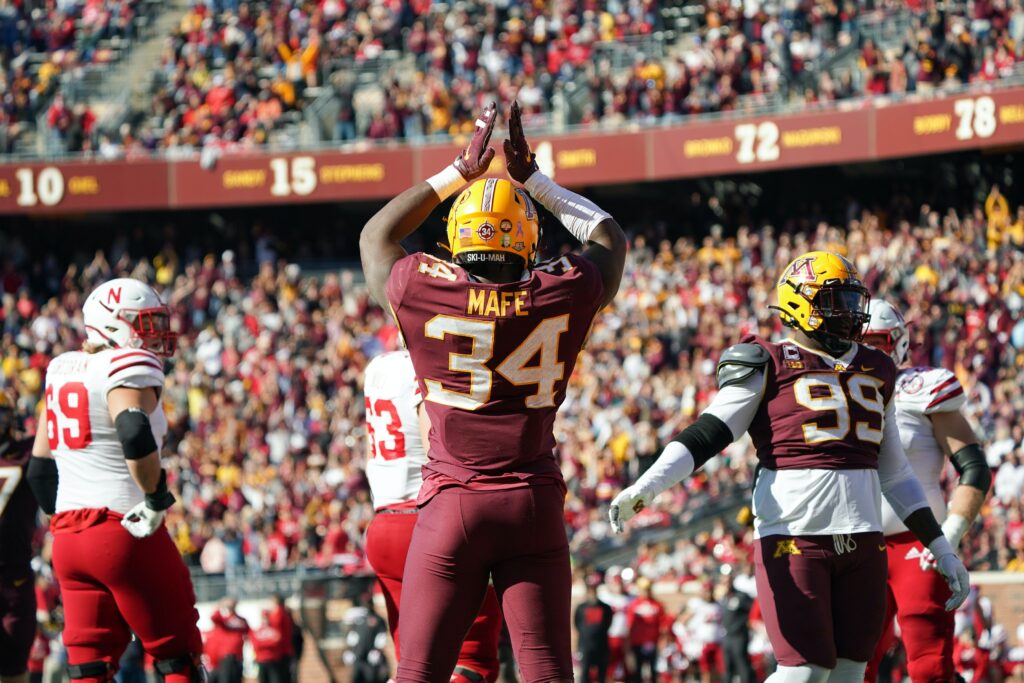
Boye Mafe will be a star performer at the 2022 combine
Defensive line
The Seahawks went against their established preferences when they selected L.J. Collier in the first round in 2019 and you could argue that is what cost them. A year later they drafted Darrell Taylor — a far more dynamic athlete — and they have been rewarded after a lost rookie season due to injury rehab.
For defensive ends or LEO’s they’ve sought twitchy athletes with great burst. Bruce Irvin and Cliff Avril ran 1.55 and 1.50 10-yard splits respectively. Anything in the 1.5’s is considered ‘elite’. In terms of defensive tackles or inside/out rushers, Rasheem Green, Quinton Jefferson, Jordan Hill, Jaye Howard and Malik McDowell all tested superbly in the short shuttle (4.39, 4.37, 4.51, 4.47 and 4.53 respectively). Alton Robinson also ran an excellent short shuttle (4.32).
Collier ran a 4.91 forty with a 1.75 10-yard split. He followed it up with a 4.78 short shuttle. His selection was a major outlier and his lack of success possibly means they’ll never make that mistake again.
Let’s call it the reverse Malik McDowell. He was 295lbs with great height (6-6) and length (35 inch arms) and ran a 4.85 with a 1.69 split. His three cone (4.53) was the same as Dalvin Cook’s. If they were swayed by the incredible traits on display with McDowell in 2017 — they might’ve adjusted their approach to account for character and grit a little too much. Collier’s struggles likely mean a return to coveting outstanding upside and traits.
So what should we look for? If we’re talking about a possible LEO or EDGE then you need to be keeping an eye out for the 1.50-1.59 10-yard splits. The splits are also important for inside/out rushers or interior pass rushers. Malik McDowell ran a 1.69 split at 295lbs. Rasheem Green ran a 1.65 at 275lbs.
Bruce Irvin (4.03) and Frank Clark (4.05) both ran incredible short shuttles. Cassius Marsh’s 4.25 and Obum Gwacham’s 4.28 were also really good. As noted earlier, many of their defensive tackle or inside/out rusher picks have also excelled in the short shuttle. Arm length is also important and they’ve consistently sought defensive linemen with +33 inch arms with Alton Robinson, a fourth round pick, the only notable outlier (32 3/8 inch arms).
Key tests
Vertical, Broad, Bench, Short Shuttle, Three-cone, 10-yard split (forty)
Ideal size
DL — +6-2, 300-310lbs, +33 inch arms, +31 inch vertical, +9’ broad, 4.50 ss
LEO — 6-4, 250lbs, +33 inch arms, 1.50-1.59 10-yard split
Positional assessment
This draft is overflowing with pass rushers. It’s an excellent looking class with several players destined to excel at the combine. On my horizontal board, I have 27 defensive linemen graded between rounds 1-3. If you want one, you can get one in the first two days. The Seahawks need to bolster their pass rush and it won’t be a surprise if one of their top two picks are spent on a defensive end or defensive tackle. Expect fireworks from this group in Indianapolis.
Interesting note
The Seahawks have selected a defensive lineman with one of their first two picks in six of the last seven drafts (Darrell Taylor, L.J. Collier, Rasheem Green, Malik McDowell, Jarran Reed, Frank Clark). With a strong D-line need this year, the chances are they’ll do it again in 2022.
Best drill to watch
Just absorb everything. The D-line drills are the most entertaining, most fan-friendly of all the combine events. The bag drills, the swim/rip drills, the club, the working in space. Football on a stick. It’s a real show of the most explosive athletes in college football competing in one venue.
Five names to watch
DT — Jordan Davis, Devante Wyatt, Travis Jones, Perrion Winfrey, Matthew Butler
EDGE — Boye Mafe, Myjai Sanders, Sam Williams, Dominique Robinson, Arnold Ebiketie
Inside/out — Josh Paschal, Logan Hall, DeMarvin Leal, Zach Carter, Dante Stills
Potential standout
Jordan Davis is going to shock everyone with the way he performs at 340lbs. His agility, quickness and mobility at that size has to be seen to be believed. His team mate Devante Wyatt is also expected to run in the 4.8’s. Boye Mafe has jumped 40.5 inches in the vertical and 10-6 in the broad, plus he can run in the 4.5’s. Josh Paschal jumped a 39 inch vertical at SPARQ and ran a 4.30 short shuttle at 253lbs.
Importance to the Seahawks?
Massively so. It’s their biggest off-season need, depending on what happens at offensive tackle. Pete Carroll has already publicly identified improving the pass rush as the key priority. This draft class aligns with that need.
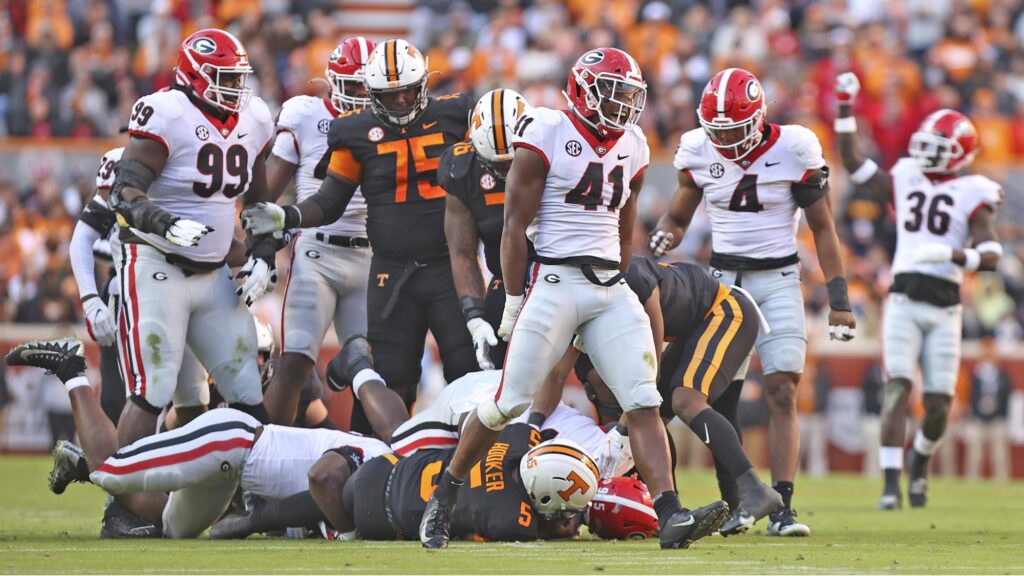
Channing Tindall once referred to himself as a ‘freak of nature’
Linebackers
The Seahawks tend to look for two types of player at linebacker — freakish athletes and players with great short-area quickness and agility.
Kevin Pierre-Louis, Korey Toomer, Malcolm Smith and Eric Pinkins all ran between a 4.44 and a 4.51 in the forty. Shaquem Griffin topped the lot with a 4.38. Pierre-Louis, Smith and Pinkins all jumped +39 inches in the vertical. Bobby Wagner was a 4.4 runner at his pro-day with a 39.5-inch vertical. Of the five players they’ve drafted with a +140 SPARQ score, Wagner, Pierre-Louis and Bruce Irvin are included. Jordyn Brooks was described as being a great tester in terms of speed and agility — although he was unable to do much testing at his combine due to injury.
They’ve also targeted players who performed especially strongly in the short shuttle. Here are the top-15 short shuttle times run by a linebacker since 2010:
Jordan Tripp — 3.96
Nick Bellore — 4.00
Ben Heeney — 4.00
Mike Mohamed — 4.00
Nick Vigil — 4.00
Kevin Pierre-Louis — 4.02
Stephone Anthony — 4.03
Cody Barton — 4.03
Dakota Allen — 4.03
Von Miller — 4.06
Josh Hull — 4.07
Dorian O’Daniel — 4.07
Avery Williamson — 4.07
Shaq Thompson — 4.08
Ben Burr-Kirven — 4.09
The players in bold have been either drafted or signed by the Seahawks during the Pete Carroll era. A third of the players.
Admittedly, Nick Bellore was signed as a full back. Even so, this isn’t a coincidence. It’s something I wrote about originally five years ago.
If there’s a linebacker who runs a great short shuttle, there’s a decent chance he will be on Seattle’s radar.
Key tests
Forty yard dash, short shuttle, vertical, broad, three cone
Ideal size
+6-0, 230-240lbs, 4.4-4.5 forty, 6.70 three-cone, +10’ broad, 4.00-4.35 short shuttle
Positional assessment
This is an incredibly deep draft at linebacker. As with other positions, there’s no Devin White-type who goes in the top-10. However, I have nine linebackers graded in rounds 2-3 with another seven listed in round four. Several of the players are expected to test superbly, such as Channing Tindall at Georgia and Leo Chenal of Wisconsin. As with the defensive linemen, this could be quite a show. If the Seahawks want a more aggressive front-seven in 2022, this is the draft to make it happen.
Interesting note
For years the Seahawks had Bobby Wagner and KJ Wright take virtually all of the defensive snaps. Wagner tallied 99.35% of the snaps in 2016, 93.08% in 2017, 93.34% in 2018, 98.32% in 2019 and 99.13% in 2020. Last season, he played 89.1%. Jordyn Brooks played 87.4%. I’m not sure this is indicative of anything but neither linebacker had the same workload in 2021 as the peak Wagner/Wright years.
Best drill to watch
Due to the importance of the short shuttle — look how the players work in space, backpedal and read/react. Quickness and change of direction is vital at linebacker.
Five names to watch
Channing Tindall, Leo Chenal, Quay Walker, Brian Asamoah, Damone Clark
Potential standout
Channing Tindall once told a press conference he’s a ‘freak of nature’. He ran a 4.19 short shuttle at SPARQ and jumped a 40 inch vertical. Keep an eye on Leo Chenal too — he’s said to have managed a 4.00 short shuttle.
Importance to the Seahawks?
They have a decision to make on Bobby Wagner. They can’t justify his $20.35m cap hit this year. They save $16.6m by cutting him. The right thing to do is to release him, let him test the market and have a conversation before he makes a final decision on his next move. If you move on — so be it. He played with hesitancy in 2021, didn’t make anywhere near enough impact plays and increasingly appears to be avoiding contact. I would prefer to save $16.6m, spend that money in the trenches and then draft a young, aggressive linebacker from this impressive draft crop and let them compete with Cody Barton and Ben Burr-Kirven.
Groups 8-10 (DB)
Arrival: Thursday 3rd March
General medical exam: Friday 4th March
Media & NFLPA meeting: Saturday 5th March
Measurements, bench, drills: Sunday 6th March

Tariq Woolen will run and jump better than anyone else in Indianapolis
Cornerback
For years everyone knew what the Seahawks liked in a corner. You had to have 32 inch arms. That changed a year ago, when Seattle drafted Tre Brown in round four. He was small (5-10, 186lbs) and had 30 3/8 inch arms. Carroll and Schneider talked about changing their approach following the success of D.J. Reed (another shorter corner lacking the typical arm length).
Reed continued to prosper in 2021 and Brown, before his injury, was viewed as a potential long-term starter.
The Seahawks still likely prefer tall, long cornerbacks. However, it’s clearly not a deal breaker any more. With Clint Hurtt also talking about the introduction of more man-coverage this year — that might be the key regarding any potential draft pick. How are your skills in man-coverage might be the bigger question rather than ‘how long are your arms?’.
Thus, speed could be vital here. Slower cornerbacks are better suited to zone, quicker cornerbacks are typically targeted to play man. You’re often facing 1v1 challenges where you have to sprint great distances, matching the receiver. You need good recovery speed. Size isn’t as important and physicality is just a bonus. I suspect, however, the Seahawks will still seek a physical edge at the position (as they did with Brown).
Keep a closer eye on the forty yard dash this year and which cornerbacks have fluidity, suddenness, smooth hips and an ability to change direction easily during drills.
It is worth stressing that the Brown pick was another day three selection at cornerback. Carroll still hasn’t taken a corner any higher than the very end of round three (Shaquill Griffin). So his/their approach in terms of physical profile might be adapting but there’s no evidence they’re more likely to draft a cornerback any earlier.
The short shuttle is again important at cornerback. In a now deleted visual demonstration of the drill, Mike Mayock explains why it’s so vital:
“It’s important for literally every position. Why? For the little guys it’s obvious. Quickness, acceleration, change of direction. How about the big guys? Can they bend? Are you a natural bender or are you a heavy-legged waist bender? A great time for a defensive back is a 4.2.”
If a great time for a cornerback is a 4.2, it’s fair to assume anything quicker than a 4.00 is exceptional.
Since 2010, only five CB’s have run a sub-4.00 short shuttle and measured with 32 inch arms:
2021 – No combine
2020 – No qualifiers
2019 – No qualifiers
2018 — Jordan Thomas (3.94)
2017 — Kevin King (3.89)
2016 — DeAndre Elliott (3.94)
2015 — Byron Jones (3.94), Tye Smith (3.96)
2010-2014 — No qualifiers
The Seahawks drafted Smith and signed Elliott. Short-area quickness and great length is a rare combination so any possible day three prospects with these physical traits will likely be on the radar.
Here are the known short shuttle times for drafted/UDFA cornerbacks in Seattle:
DeAndre Elliott — 3.94
Tye Smith — 3.96
Jeremy Lane — 4.14
Shaquill Griffin — 4.14
Deshawn Shead — 4.23
Brandon Browner — 4.24
Richard Sherman — 4.29
Tharold Simon — 4.31
Byron Maxwell — 4.49
Tre Flowers — 4.34
Tre Brown — 4.27
What about the nickel corner position? Justin Coleman was their last truly successful nickel. He was only 5-11 and 185lbs at his combine with 31 1/4 inch arms. He did, however, run a blistering short shuttle (3.98) and jumped a 37.5 inch vertical. It’s worth considering highly athletic nickel corner candidates, especially with Marquise Blair’s injury history and Ugo Amadi’s poor 2021 season.
Key tests
Short shuttle, vertical, forty
Ideal size
+5-10, 195lbs, +32-inch arms, 4.40 forty, +35-inch vertical
Positional assessment
There are some excellent cornerbacks in this draft and with the growing desperate need at the position, several could go in the top-20. Derek Stingley, Sauce Gardner, Kyler Gordon, Trent McDuffie and Tariq Woolen could all be early picks — with a handful of others close behind. Stingley, Gordon, McDuffie and Woolen could blow the roof off in Indianapolis with their testing numbers. This could be a superstar workout day. I have 13 cornerbacks graded between rounds 1-3. There are plenty of very attractive options here and the Seahawks — with two early fourth round picks — should be able to find a corner they like.
Interesting note
Despite being lauded for their ability to draft and develop cornerbacks in the early Carroll era — the Seahawks have surprisingly only drafted one in the last four drafts. They converted Tre Flowers from safety and have used Amadi as a nickel. They’ve also struggled at the position. So none of this makes sense. In fairness — they showed something of a return to form in 2021. Reed and Sidney Jones performed well and a collection of no-name backups filled in admirably. It’s encouraging.
Best drill to watch
The backpedal drill. Watch to see how the cornerback transitions and whether it’s effortless. Do they have loose hips and do they explode out of their break? Is their footwork smooth or clunky? Are they laboured in any way or does it just look natural?
Five names to watch
Tariq Woolen, Kyler Gordon, Montaric Brown, Josh Williams, Akayleb Evans
Potential standout
Tariq Woolen could run in the 4.2’s. He’ll also excel in the jumps. Derek Stingley could’ve beaten him though as a former 142.74 SPARQ leader but it was revealed today he won’t compete at the combine as he continues to recover from a Lisfranc injury. Kyler Gordon could also make waves — he’s capable of a 42.5 vertical and has clocked a stunning 3.87 short shuttle at Washington.
Importance to the Seahawks?
It depends what happens in free agency. At the moment, Tre Brown is the only contracted cornerback on the roster and he’s recovering from a serious injury. If they re-sign Reed and Jones and retain ERFA’s John Reid and Gavin Heslop they boost their numbers. Richard Sherman also linked them to man-coverage dynamo Stephon Gilmore last week. They need to do something here, that’s for sure.
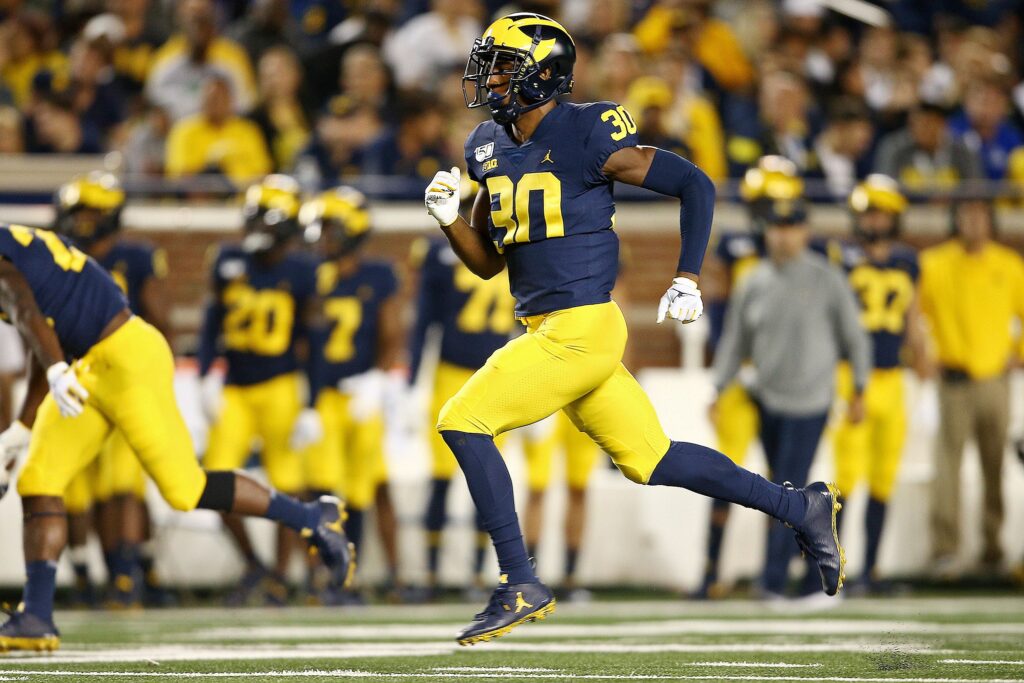
Daxton Hill is a former SPARQ star and top HS recruit
Safety
After hitting on Earl Thomas and Kam Chancellor in 2010, Seattle hasn’t had much success at the safety position. Ryan Murphy, Winston Guy, Mark LeGree, Tedric Thompson and Delano Hill have come and gone. Marquise Blair has had injury issues throughout his NFL career. The less said about the Jamal Adams trade the better.
Thankfully, the Quandre Diggs trade worked out.
There’s a real mix of physical profiles in the players they’ve taken, making it a difficult position to project. Murphy ran a 4.48 at his pro-day with an impressive 39-inch vertical and Blair ran a 4.48 with a 35-inch vertical but Legree (4.59) and Guy (4.70) didn’t run fast times (Legree only had a 31-inch vertical too). Hill ran a 4.47 but Thompson managed only a 4.60.
Diggs has 29 5/8 inch arms and ran a 4.56. Adams also ran a 4.56 but excelled in the short shuttle (4.13) and had +33 inch arms.
Overall it’s hard to describe a Seahawks ‘type’. The only safety they’ve drafted in the first round (Earl Thomas) was a tremendous athlete. He ran a 4.37 at his pro-day after pulling a hamstring running the forty at the combine (while still managing an official 4.49). Blair, their next highest pick at the position, was also athletic and hit like a sledgehammer.
Of all the positions, this might be the one without a clear established physical ideal. It could be the position where scouting or attitude influences things the most.
Key drills
Forty yard dash, Three-cone, Vertical, Broad
Ideal size
+6-0, 200-220lbs, 4.4 forty, +39-inch vertical, +10-5 broad jump
Positional assessment
It’s top-heavy. Kyle Hamilton will be a top-10 pick as a rangy, tall field-general. Daxton Hill is expected to be a top-tester and could end up with first round grades. I think Jaquan Brisker is a bit overrated but he too is expected to test well. There are a cluster of players I really like — the rangy Kerby Joseph, the physical Lewis Cine, the all-round qualities of Bryan Cook and Nick Cross. Others prefer Jalen Pitre. After those names — the position falls off a cliff.
Interesting note
Both Earl Thomas and Tedric Thompson had a lot of interceptions in their final college seasons and both were drafted to play free safety. Thomas had eight picks for Texas in 2009, Thompson had seven for Colorado in 2016. Looking at this draft class, Verone McKinley III had six interceptions in 2021 and Kerby Joseph had five. Montaric Brown, who I really like at cornerback, also had five. Some have suggested he transition to safety (I’d keep him outside).
Best drill to watch
Any of the drills requiring the safety’s to close in space and show off their open-field quickness and range.
Five names to watch
Daxton Hill, Kerby Joseph, Lewis Cine, Bryan Cook, Nick Cross
Potential standout
Don’t be surprised if Daxton Hill tests so well that people discuss a switch to cornerback. At SPARQ he ran a 4.30 forty, a 4.13 short shuttle, jumped a 44-inch vertical and finished with an overall score of 143.76. He could be the star of the whole event this year.
Importance to the Seahawks?
The Seahawks have pumped resource into this position and it hasn’t worked. It’s time to shift money and investment from safety and linebacker into the trenches. They need to be prepared to move on from Quandre Diggs if he’s too expensive, having already spent (wasted?) $17.5m a year and a kings ransom of picks on Jamal Adams. Draft a cheaper replacement or sign a cheaper veteran unless the market comes to you. Diggs is good but he’s not ‘great’.
Assessing 2020’s ‘names to watch’
Typically I like to look back on the previous year and check back on the names we highlighted. However, with no combine a year ago, we’re left to reflect on the 2020 draft.
Here’s the first name I listed for every position group:
Hunter Bryant (TE) — He ran a 7.08 three cone and a 4.46 short shuttle so performed well. Injuries impacted his stock, though, and he ultimately went undrafted.
Justin Herbert (QB) — He showed off his extreme physical talent at the combine and has since proven to be one of the NFL’s blossoming stars.
Brandon Aiyuk (WR) — He only ran a 4.50 forty but added a 40 inch vertical. The 49ers traded up to select Aiyuk with the #25 overall pick.
Damien Lewis (G) — A blog favourite who had a reasonably explosive testing performance and was drafted by Seattle in round three.
Cesar Ruiz (C) — A brilliant testing performance secured a first round placing. It was a surprise New Orleans took him at #24 having already drafted Erik McCoy the year before and Ruiz has struggled after switching to guard. He needs a fresh start (nudge nudge Seattle).
Isaiah Wilson (T) — Character issues ruined his career before it even began. What a waste. He was taken in round one after a strong combine.
Jonathan Taylor (RB) — He ran a 4.39 forty, jumped a 36 inch vertical and had the perfect running back frame. He was taken with the 41st pick by Indianapolis and has become a star.
Raekwon Davis (DT) — He had a Calais Campbell frame but he had middling testing results including a 28 inch vertical. He was the #56 pick, taken by Miami, and had a 36.5 PFF grade in 2021.
Julian Okwara (DE) — He didn’t do any testing during the pre-draft process and fell to round three. He’s suffered injuries with Detroit but had five sacks in 13 games in 2021.
Willie Gay Jr (LB) — He ran a brilliant 4.46 at 243lbs, jumped a 39.5 inch vertical and an 11-4 broad. He also ran a 4.30 short shuttle. Terrific performance, helping to secure a spot in round two. Jordyn Brooks was third on my list.
Trevon Diggs (CB) — He always had the talent but fell to round two after an indifferent final season in Alabama. Diggs also didn’t test pre-combine. He was taken with the 51st pick and has 14 interceptions in two years for Dallas.
Grant Delpit (S) — Early in his career, Delpit looked like the next superstar safety at LSU. For some reason it has never happened. He dropped to round two and hasn’t really impacted the NFL.
The week ahead
Throughout the combine I’ll be producing a live blog as events unfold, followed by a reflective piece at the end of each day. I’ll also be delivering regular live streams to offer thoughts and observations. My podcast partner Robbie Williams is attending the combine and will also provide his own reaction from Lucas Oil Field.
If you enjoy the content on Seahawks Draft Blog then please consider supporting us via Patreon (click the tab below)…
Become a Patron!

















